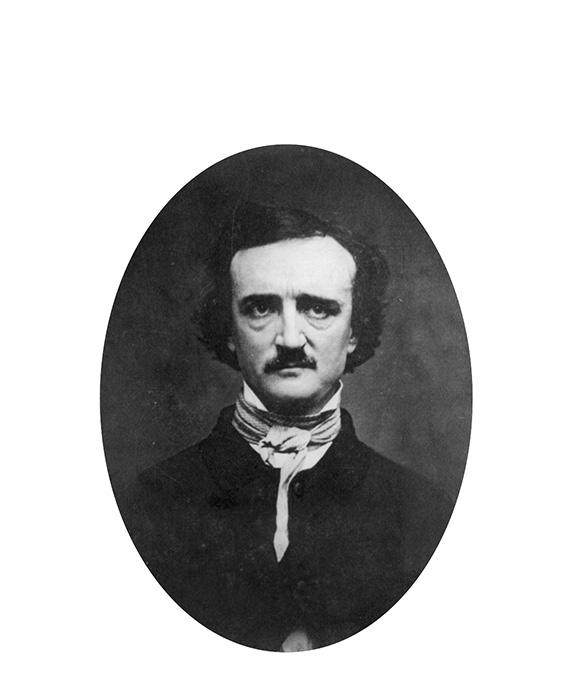The Slender Poe Anthology
Read The Slender Poe Anthology Online
Authors: Edgar Allan Poe



Library of Congress

Copyright © 2013
Sacramento Public Library
All rights reserved.
This book may not be reproduced, in whole or in part, in any form (except by reviewers for the public press), without written permission from Sacramento Public Library.

Library of Congress Cataloging-in-Publication Data
Poe, Edgar Allan, 1809â1849
Slender Poe Anthology, The / Edgar Allan Poe ;
introduction and commentary by John Allen Cann ;
foreword by Rivkah Sass.
xii, 251 pages, 23 cm.
ISBN 13: 978-0-9889839-6-0 (paperback)
1. Fiction â Horror Tales â 19th Century. 2. Poetry, Modern â 19th Century. 3. Literature, Modern â 19th Century.
4. Anthologies â American Literature â 19th Century.
I. Poe, Edgar Allan. II. The Slender Poe Anthology.
III. Cann, John Allen.
Library of Congress Control Number: 2013914008

Cover design and book layout by Laura Koivunen for Sacramento Public Library. The text of this book is set in ITC New Baskerville and Calendas Plus. Printed on the Sacramento Public Library's I Street Press Espresso Book Machine.
Printed in the United States of America.
CONTENTS
Foreword
Introduction
Eleonora
To Helen
Eldorado
Shadow â A Parable
To One in Paradise
Hop-Frog
The Masque
of
the Red Death
The City in the Sea
The Power
of
Words
Silence â A Fable
Alone
Letter to Mr. Bâââ, 1831
Sonnet â to Science
The Domain
of
Arnheim
The Oval Portrait
The Colloquy of Monos and Una
The Conqueror Worm
The Conversation of Eiros and Charmion
Israfel
To âââ
Lines from the Critical Prose
The Raven
Regarding C. Auguste Dupin
The Purloined Letter
The Haunted Palace
The Imp
of
the Perverse
The Bells
Annabel Lee
The Premature Burial
FOREWORD
Rivkah K. Sass, Library Director
Welcome to our annual One Book Sacramento celebration in which everyone in our community reads, discusses and celebrates the same book. Our selection this year is a special one. Thanks to a member of our creative community, John Allen Cann, professor of literature and English composition at Cosumnes River College, our extraordinary graphic designer, Laura Koivunen, and the wild idea, “What if weâ¦,” we are so pleased to present
The Slender Poe
, our own anthology of Edgar Allan Poe.
As far as we know,
The Slender Poe
is unique. Of the libraries around the world that have sponsored “one book, one community” events since Nancy Pearl conceived the idea in Seattle in 1998, we believe that Sacramento is the first to curate and publish its own collection.
Edgar Allan Poe is uniquely American. His incredible creativity, his tragic life and his mysterious death add to the mythology of Poe. He is credited with writing the first detective story and for inspiring Arthur Conan Doyle. All the women in his life died tragically. He might have been an alcoholic. In other words, if Edgar Allan Poe were around today, he would be a rock star.
We are grateful to the Friends of the Pocket-Greenhaven Library, an affiliate of the Friends of Sacramento Public Library, for their generous support in producing
The Slender Poe
. They believed in our idea and helped us make it so!
We offer this collection with the hope that you will discover or rediscover Edgar A. Poe, read some old favorites, discover some new works and celebrate your freedom to read.
Thank you.
INTRODUCTION
John Allen Cann
I don't know if Wallace Stevens had Edgar Allan Poe in mind when he penned, “Authors are actors, books are theaters,” but he might as well have. For Poe, there is a keen theatric dimension to his tales and poems; every page is a stage. His work calls out to be read aloud, to be given voice. It's the best way to savor his words. And his words have proven to be among the most influential ever written by an American.
Let's begin with
Seven Keys
to his life:
Key No. 1 â All the Men and Women Merely Players.
Poe's parents were both thespians. His mother, English-born Elizabeth Arnold Poe, had been working American stages since she was 9, developing into a very popular actress, noted for her attractive looks, sweet voice and comedic skills. Eliza took her turn with major Shakespearean roles, too, playing Ophelia and Juliet before New England audiences. Her second husband, David Poe, Jr., was not her equal on the boards; by all accounts, his good looks were in advance of his histrionic skills. He possessed a quick temper and a proclivity for excessive drink. Edgar was born January 19, 1809, while the pair were playing Boston. By July of the following year, David Poe had disappeared, leaving his pregnant and consumptive wife with their two small boys.

Key No. 2 â Groomed For a Life He Could Never Afford.
At age 24, Eliza Poe died in Richmond, Virginia, on December 8, 1811, with Edgar likely present at her death. The next morning, Francis Allan, one of the “kind hearted of the city” who had taken a charitable interest in the dying actress and her children, came for Edgar. After some initial resistance, “Fanny” persuaded her Scottish-born husband, John, to bring Edgar into their childless home. Though never formally adopted, he was reared as their son with all the expectations of his becoming a Southern gentleman. His youth included a five-year stint in Britain, mostly in London, where John Allan brought his family while endeavoring to expand his mercantile business. His venture failed and his debts were considerable by the time he returned with his family to Richmond in 1820. Already tense, Edgar and Allan's relationship became more volatile in the following years.

Key No. 3 â Athlete, Scholar, Soldier.
Never more than 5' 8” and slight of build, nevertheless, in his youth Poe was athletic: a boxer, swimmer and gymnast. He had the gift for leadership among his childhood friends. His skill with languages was in evidence early, as was his interest in writing poetry. At 17, he entered the University of Virginia, where he distinguished himself academically but, in an effort to compensate for a shortage of funds, he took up gambling with classmates and incurred considerable debts. His lifelong problem with drinking began in earnest here. He didn't return for a second year; John Allan saw no reason to honor his ward's debts; fractious rows ensued. The grievances Poe and Allan had with each other climaxed with Edgar's angry departure early in 1827 from Moldavia, the mansion Allan had built after inheriting a fortune from a wealthy uncle. By May, Poe had enlisted in the U. S. Army as “Edgar A. Perry.” The military life gave him structure and focus; he was rapidly promoted to the rank of sergeant major. His eyes turned toward West Point and the career of a commissioned officer. Fanny Allan died just after Poe turned 20; he wasn't called home for a final farewell. With John Allan's help, he entered the academy in May of 1830; however, his fortunes took a hard downturn when Allan remarried later that year in October, severing all ties with Poe.

Key No. 4 â Pale and Spectre Thin.
Consumption, or tuberculosis, was the all-too real bugaboo of Poe's life. The three most significant women in his lifeâhis mother, Eliza, his foster mother, Fanny, and his wife, Virginiaâ each slowly faded into death through its agency. As scholars have since noted, at the time the disease was thought romantic and even fashionable.

Key No. 5 â Magazinist.
Disenchanted with the prospects of a military life, Poe engineered a friendly court-martial. On his own, he began writing for and working in the fast-growing American industry of magazines and journals and would do so the rest of his life. His first tales appeared in the
Saturday Courier
of Philadelphia during 1832, anonymously. Three years later, he was back in Richmond, working for the
Southern Literary Messenger
, where he began to develop a national reputation as editor, critic and fiction writer.

Key No. 6 â Til Death Do Us Part.
In May 1836, Poe married his cousin, Virginia Clemm, who was almost 14 years old. The newlyweds' household was managed by Maria Clemm, her mother. This was to be the nuclear trio of Poe's most secure domestic circumstances. Virginia and her mother adored Poe. Virginia, pretty, plump, and possessed of gentle manners, a lovely voice, and a child-like simplicity, was the love of Poe's life. In 1842, while singing at their piano, she began to bleed from her mouth; for the next fortnight, she was perilously ill, close to death. She recovered, but never fully; consumption made its claim. The fluctuations of her health were an emotional rollercoaster Poe would ride until her death in 1847, eleven days after his 38th birthday. After her passing, Poe was never quite the same.

Key No. 7 â Lost Days of the Final Trip.
Poe sank into depression and drink for the rest of 1847, a hard year: Muddy Clemm and Marie Louis Shew nursed him back from the abyss. The following year, his health and productivity improved, though he began a series of somewhat frenzied romances, proposing to several of the women. He was lecturing and trying to raise money for his own journal,
The Stylus
. In early summer 1849, Poe arrived in Philadelphia during a cholera epidemic; hallucinations beset him from a mix of medication, alcohol, and extreme anxiety; he ended up having to be ministered back to health by friends. One of them paid for his train trip to Richmond, where he was reunited with his boyhood sweetheart, the widowed Elmira Royster Shelton, to whom he became engaged. A few days after he delivered his lecture,
The Poetic Principle
, to an admiring and appreciative audience, he boarded a ship for Baltimore. A week after his arrival, a week whose events will remain forever unknown, he was found âthe worse for wear' in clothes not his own, outside a polling booth, delirious. Four days laterâwhile under hospital careâon October 7, 1849, he died from what was termed “congestion of the brain.”

In the days approaching his untimely death, Poe wrote, “I do believe God gave me a spark of genius, but he quenched it in misery.” Fate was unkind to Poe; misfortune badgered him all his life. Yet, would he otherwise have created such a wildly singular and enduring body of work? In his creativity and his visions, I like to think Poe had his bliss, that he gave truth to the words of Kahlil Gibran's
The Prophet
, “The deeper sorrow carves into your being, the more joy you can contain.”
In his brief essay, “The Poet,” Carl Jung writes, “Creativeness, like the freedom of the will, contains a secret.” It's simply quite staggering how much has been written about Poe, yet some secret remains inviolate regarding just how this man came up with the work he did.
